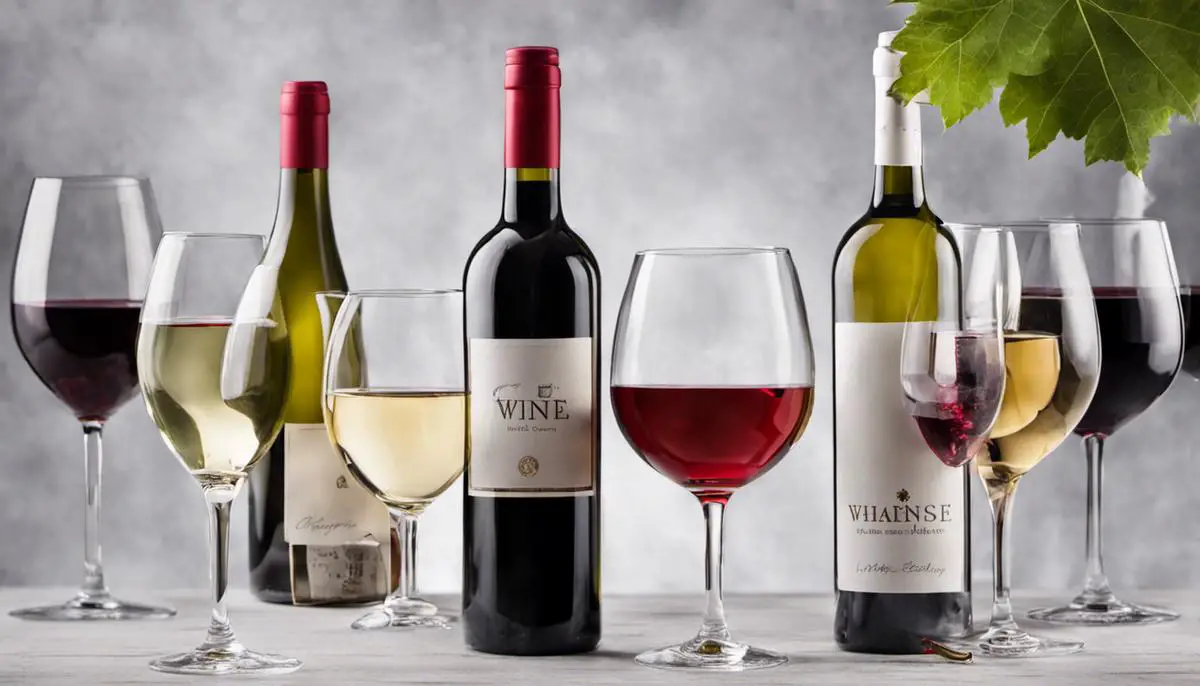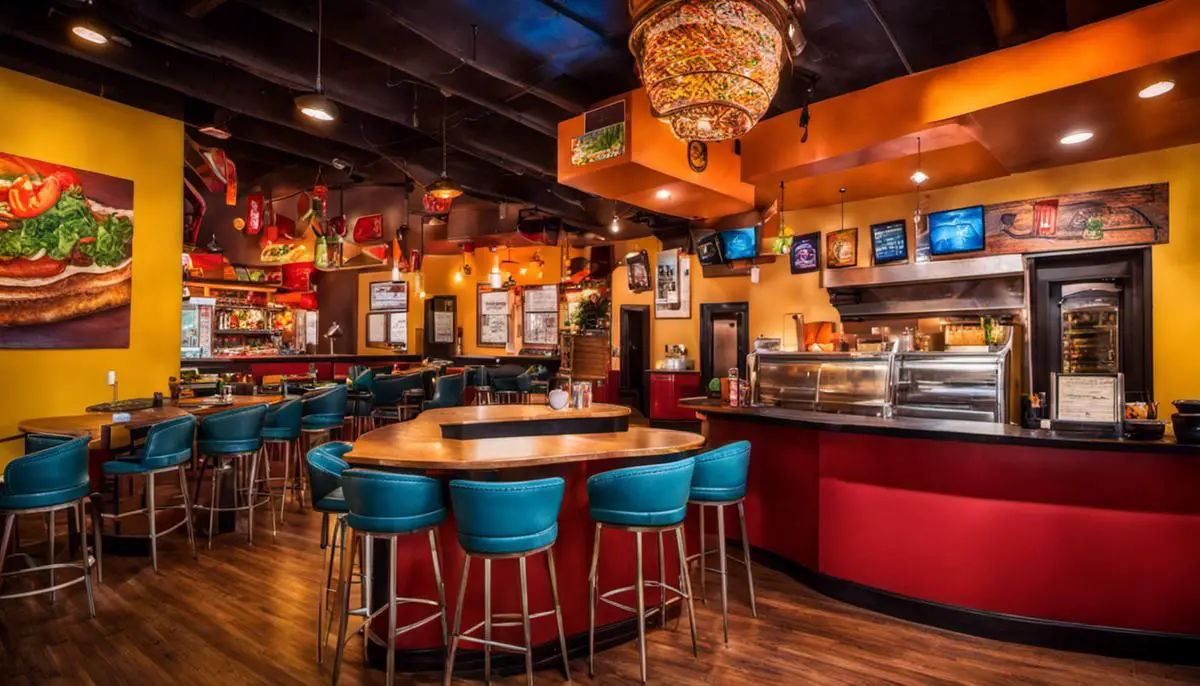Selecting the perfect wine for a dinner party can be a daunting task. Wine, often considered the elixir of joy, is more than just a beverage – it’s an experience that can enhance any dinner gathering or party. As an intricate beverage with numerous types and cultivars, it offers endless opportunities for exploration and savoring.
This in-depth guidance introduces you to the vibrant world of wines, from breaking down fundamental details like types, wine-producing regions, and grape varieties to technical vocabulary, including body, tannin, and acidity. We’ll also guide you through understanding your dinner menu to pair wine confidently, read wine labels, budget for wine according to your event, and conclude with wine serving etiquette. Let’s dive into this fascinating world and elevate your dinner parties with a touch of viniculture.
What We Will Cover
Understanding Wine Basics

Understanding Wine Basics
The understanding of wine begins with its most basic categories, which are red, white, and rosé. Red wines are made from black grapes fermented with their skins, providing the wine an intense flavor, rich color, and higher tannin levels. Popular varieties include Cabernet Sauvignon, Merlot, and Pinot Noir, all offering unique flavor profiles.
White wines, on the other hand, are typically made from green grapes which have been fermented without their skins, resulting in a lighter, often fruit-forward fare. Chardonnay, Sauvignon Blanc and Pinot Grigio are among the most renowned white wines with a wide variety of taste notes ranging from crisp and citrusy to rich and creamy.
Rosé wines straddle the line between red and white, often made from black grapes with skin contact limited to few hours to give them a lighter, pinkish hue. Varying from dry to sweet, rosé wines like Grenache Rosé and Provence Rosé are often preferred for their versatile nature.
Major Wine Producing Regions
The world’s major wine-producing regions greatly influence the taste, aroma, and quality of wines, and are imperative to wine selection. France, Italy, and Spain are among the top wine-producing countries, each boasting distinctive styles and quality grading systems.
France is well-known for its Bordeaux, Burgundy, and Champagne regions, while Italy is famous for its robust reds like Barolo and Chianti and crisp whites like Pinot Grigio. Spain is home to Rioja and Ribera del Duero, among others, known for their Tempranillo grape wines.
New World wine regions have also been significantly impacted, with areas like California, Australia, and Chile producing high-quality Cabernet Sauvignons, Shiraz, and Carménère, respectively.
Mastering the Basics of Wine Terminology
Infographic for wine-tasting vocabulary & descriptions
byu/princesslea20 inwine
Finding the perfect wine for a dinner party means going through the wine selection process. It becomes easier when you understand some key wine terminology, primarily when it’s associated with deciding the best pairings for your cuisine. The term ‘body’ defines the weight or density of the wine and is typically labeled as light, medium, or full-bodied. Factors such as alcohol percentage, amount of sugar, and the variety of grape used all influence the body of a wine.
‘Tannin’ is a popular word you’ll come across when talking about red wines. It signifies the sharp compounds originating from the grape’s skins, seeds and stems. Wines with high tannin levels can cause a dry, slightly bitter sensation, but they also add depth, intricacy, and longevity to the wine.
Speaking of ‘acidity’, the sharp or sour taste in wine can make it appear more refreshing and brisk. Acid-heavy wines like Sauvignon Blanc or Chardonnay are typically excellent options to pair with seafood or fish, whereas wines with lower acidity, like most reds, work wonderfully well with meatier dishes.
Grasping these integral elements of wine – understanding the different varieties the top wine-producing countries, and familiarising yourself with some important wine terminology – you’re at a better place to make informed decisions and select the most fitting wines for your dinner event.
Analyzing Your Dinner Menu

Deciphering the Dinner Menu
In order to allocate the best corresponding wine for your dinner party, having a solid understanding of the food menu is vital. The art of wine pairing involves harmonising the wine’s unique characteristics such as aromas, textures, and flavours with those of the food to be served. Your main goal should be to opt for wines that not only stands alone but also enhances the flavours of your chosen dishes, hence taking the entire dining experience to the next level.
Dominant Flavors and Wines
Dominate flavors in your dishes play a significant role in determining the right type of wine. The flavors can range from light to robust, and from rich to lean. The trick to achieving an ideal pairing lies in not letting the food overpower the wine or vice versa.
If you have a dish with a robust flavor – like a heavy meat dish or spicy foods – it will pair well with red wines like Cabernet Sauvignon or Shiraz; lighter dishes with a lean flavor go well with lighter wines like Chardonnay or Pinot Grigio. Creamy, fatty dishes pair well with chardonnay, a full-bodied white wine.
Consider the Cooking Methods and Spices
Also, consider how your meals are prepared. Grilled or roasted foods usually have a smoky flavor, which pairs well with wines that have been aged in oak, like Chardonnay or Cabernet Sauvignon. For spicy meals, a sweet white like Riesling or Gewurztraminer can counteract the heat while also complementing the intense flavors.
Achieving a Harmonious Meal
Your goal is to not only pick a wine that pairs well with one dish but one that harmonizes with the entire menu. This requires a careful balancing act of flavors. You can either choose a versatile wine that pairs well with a variety of dishes or provide a selection of wines that guests can experiment with.
Clean, crisp wines such as Sauvignon Blanc or Chardonnay can cleanse the palate, making them a good choice if your menu includes a variety of different flavors. For an array of cheese, you can opt for a wine like a Riesling, which tends to be versatile when it comes to cheese pairings.
Beware of Food and Wine Conflicts
While some flavours complement each other, others can significantly conflict. For instance, pairing a sweet wine with sweet food could make the wine taste less sweet and more acidic. Another conflicting pairing is a tannic wine (like Cabernet Sauvignon) and oily fish – the wine can make the fish taste overly metallic.
Whether you are a wine connoisseur or a novice, the first step towards a successful wine pairing is to understand your menu. Take note of the main flavors, the methods used for cooking, and the seasonings that will influence the body and type of wine that complements your dishes well. Ultimately, the goal is to create a balance between the flavors in the wine you choose and your complete dinner menu, thus assuring a satisfying dining experience for all.
Reading the Wine Label

Decoding Wine Labels for a More Informed Selection
At first glance, wine labels may appear intimidating, but they become less challenging as you become acquainted with the key aspects. Each label on a wine bottle is like a detailed map, guiding you towards understanding the wine’s quality, flavor, and hence its suitability for your dinner party. So don’t be put off; get involved and explore these resources to enhance your wine selection process.
Producer Name
The producer or winery name on a wine label gives you the first insight into the bottle’s content. The producer’s reputation often speaks volumes about the wine you are selecting. Some are known for their consistency in quality while others may be praised for their innovation and uniqueness. It’s worth doing a bit of research into the reputation of the producer.
Vintage Year
Looking at the vintage year on the wine label offers information about the climate and growing conditions of the vineyard that year. Generally, a good year has optimal conditions that produce high-quality grapes, and therefore better wine. But remember, ‘older’ doesn’t always mean ‘better.’ Some wines are meant to be consumed young.
Region of Origin
The region or appellation listed on the wine label represents where the grapes were grown. Winemaking regions each have unique climates and soil conditions, influencing the flavor and character of the wine. Some regions also have stringent quality control laws, so wines from these regions are typically reliable choices.
Alcohol Content
The alcohol content, referred to as ABV (Alcohol By Volume), is typically listed on the wine label as a percentage. Wines with a higher ABV (13.5%-15%) are usually bolder and heavier, while those with a lower ABV (10%-12.5%) tend to be lighter and potentially sweeter. Based on your meal, you might want to balance the boldness of your wine with your dishes, or perhaps you’d prefer a lighter, refreshing choice for a summer evening.
Blend or Single Varietal
Understanding if the wine is a blend or single varietal can also guide your selection for your dinner party. Single varietal wines are made from one type of grape, such as Merlot or Chardonnay, and often highlight the unique flavors and characteristics of that specific grape. A blend, as the name suggests, is a mix of different types of grapes, producing a harmonious combination of flavors.
Your choice between a single varietal or blend may depend on the dishes you are serving or your personal taste preferences. For instance, a spicy dish might be complemented by a bold, full-bodied blend, while a light salad might pair well with a single varietal Sauvignon Blanc.
Wine Knowledge Overview
Understanding the critical information on a wine label can immensely upgrade the wine selection process for your dinner party. Vital details such as the winemaker’s name, the year of the vintage, the place where the grapes were grown, the percentage of alcohol, and whether the wine is a blend or a single varietal are all essential in discerning what the bottle contains. By grasping these aspects, you can conveniently pick wines that not only complement your meals but also instigate intriguing exchanges among your guests.
Budgeting for Wine

Setting a Wine Budget: An Effective Guide
Arranging a dinner party requires a careful eye for numerous details, one of which includes the choice of wine. The right wine can add an extra dimension to the dining experience, pairing beautifully with the flavors of the dishes served. Nevertheless, the expense attached to wines can mount rapidly, especially when entertaining a large crowd. Hence, devising a sound strategy for wine budgeting can ensure you maintain affordability while not compromising on the quality, thereby guaranteeing the overall success of your dinner party.
Understanding Wine Consumption
To begin with, it’s crucial to gauge wine consumption. Broadly speaking, a standard 750ml wine bottle serves around five glasses. Assuming each guest has two to three glasses of wine, one bottle can cater to two guests. Therefore, you should ideally budget for around five wine bottles for a gathering of ten guests. Remember, having more wine than less is always better, as the latter can lead to an awkward situation if you run out mid-party.
Seasonal Sales and Discounts
Exploiting seasonal sales and bulk purchase discounts is a brilliant way to adhere to your budget while ensuring variety and quality. Liquor stores and supermarkets often offer discounts during festive seasons, holidays, or when they are trying to clear their inventory. These discounts can be quite substantial and can provide excellent cost-effective choices for your dinner party.
Quantity Discounts
Many wine shops and online outlets offer quantity discounts. In this case, the unit cost per bottle of wine decreases when you purchase a larger number. Consider buying a case of wine instead of individual bottles, as you can save significantly. However, be sure to mix and match within the case so that you have a variety of wines for paired food options.
Online Shopping
Online shopping platforms can also provide access to an impressive array of affordable wines. Online retailers often run promotions and offer discounts if you purchase directly from them. They can give you access to reasonably priced domestic and international wines, which are perfect for those looking to explore different wine regions on a budget.
Warehouse Clubs
Warehouse clubs like Costco and Sam’s Club sell popular wine brands at prices that often undercut traditional liquor stores. Besides, these clubs also carry their exclusive brands that have received high praise from industry experts. Membership to these clubs can be an excellent investment for a regular wine buyer, giving you high-quality wines at budget-friendly prices.
Bottom Shelf Finds
An interesting way to discover affordable, good-quality wines is to scan the bottom shelves of your local wine shop or supermarket. Contrary to popular belief, there are many excellent wines that don’t make it to eye level and are surprisingly affordable.
BYOB Restaurants
If you’re planning a restaurant dinner party, consider a BYOB restaurant. You’ll have full control over the wine selection and costs, and you can invest more in food or keep the savings. Make sure to budget for the potential corkage fee, which can still be much less than restaurant wine markups.
Considering Your Guests
When planning your budget for a dinner party, it’s crucial to keep your guests’ preferences in mind rather than focusing solely on buying expensive wines. The success of any gathering greatly depends upon creating an ambiance where top-notch yet affordable wines greatly enhance the overall enjoyment.
Wine Serving Etiquette

Knowing Your Wines and Their Pairings
The secret to selecting the perfect wine to accompany your dinner party lies in recognizing the key features of the most popular variants. For instance, red wines such as merlot, cabernet sauvignon, and pinot noir pair wonderfully with heavy, meat-based courses. On the other hand, lighter dishes like seafood or chicken suit white wines like sauvignon blanc, chardonnay, or riesling better.
Ideal Serving Temperatures
Each type of wine has a specific temperature range at which its flavors are best enjoyed. Full-bodied reds like cabernet sauvignon perform well at temperatures between 60-65 degrees Fahrenheit, while light-bodied reds such as pinot noir are best served slightly cooler, around 55-60 degrees. For white wines, aim to serve them chilled, but not ice-cold, to avoid masking the subtle flavors. A good range for most white wines is 45-50 degrees. Sparkling wines and Champagne usually taste their best around 40 degrees.
Decanting Basics
Decanting is a process used primarily for red wines to separate the sediment from the wine and also to allow the wine to “breathe”, enhancing its full flavor profile. Leave the wine in the decanter for at least 30 minutes to an hour before serving. However, not all wines benefit from decanting. Many white wines, for instance, can be served directly from the bottle.
Wine Glass Selection
The choice of wine glass can also significantly impact your wine tasting experience. Red wines are best served in glasses with larger, rounder bowls to allow the aromas to circulate. A glass with a narrower bowl is ideal for white wines to capture their delicate aromas and to help maintain a cooler temperature. When it comes to sparkling wines, a flute or tulip shape is perfect to allow the bubbles to ascend to the top, preserving the effervescence and directing the aroma to your nose.
Order of Serving Wines
If you are serving multiple types of wines throughout the evening, make sure to serve them in the correct order to optimize the tasting experience. As a general rule, start with lighter wines, both in color and body, and move onto heavier ones. This means serving sparkling wines first, followed by light to medium whites, then onto full-bodied whites or rosé wines, light to medium-bodied reds, and finally, end with full-bodied reds and dessert wines.
Remember, etiquette doesn’t have to be intimidating. The main goal is to enhance your enjoyment of wine and contribute to a memorable dinner experience.
Final Thoughts About Selecting the Perfect Wine for a Dinner Party

This comprehensive guide has taken you through a journey in the world of wines – from understanding the basic terminology to choosing and serving the perfect bottle for your dinner party. The bounty of knowledge on reading wine labels and budgeting for your selection ensures that you’re making informed decisions and getting the best value.
When you understand the nuances of your menu and the corresponding wines to pair, you’re set to offer an unforgettable gastronomic experience to your guests. Just remember that wine etiquette adds a polished finish to the whole experience. Now that you’ve acquired this fundamental wisdom elevate your dinners with the artful inclusion of wine. Enjoy your voyage in wine selection!
Related Reading
The Fascinating Journey of Homemade Prison Wine – From Prison Cells to Wine Cellars




